
The Scorpaeniformes are a diverse order of ray-finned fish, including the lionfishes and sculpins, but have also been called the Scleroparei. It is one of the five largest orders of bony fishes by number of species, with over 1,320.
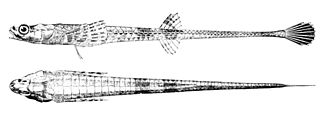
Agonidae is a family of small, bottom-dwelling, cold-water marine fish. Common names for members of this family include poachers, Irish lords, sea ravens, alligatorfishes, starsnouts, hooknoses, and rockheads. They are notable for having elongated bodies covered by scales modified into bony plates, and for using their large pectoral fins to move in short bursts. The family includes about 59 species in some 25 genera, some of which are quite widespread.

Anoplopomatidae, the sablefishes, are a small family of ray-finned fishes classified within the order Perciformes. These fishes are found in the North Pacific Ocean.

The grunt sculpin or grunt-fish is a small fish mainly found in the eastern Pacific Ocean. The grunt sculpin generally remains close to shore and is often found in empty giant barnacle shells. The common name comes from reports that the fish vibrate or "grunt" when held. Its defining feature is its tendency to “hop” along the ocean floor on its orange fins. The short, stout body of the grunt sculpin has a long, small mouth which is adapted for eating smaller prey.
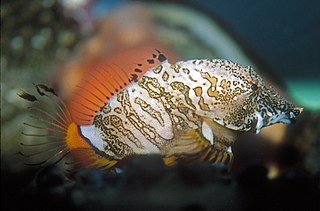
Rhamphocottus is a genus of marine ray-finned fishes belonging to the family Rhamphocottidae. These fishes are known as grunt sculpins. The grunt sculpins are found in the North Pacific Ocean.

Hexagrammidae, the greenlings, is a family of marine ray-finned fishes belonging to the suborder Cottoidei in the order Perciformes. These fishes are found in the North Pacific Ocean.

Pholidae is a family of marine ray-finned fishes, known as gunnels, in the scorpaeniform suborder Zoarcoidei. These are fishes of the littoral zone and are mainly found in North Pacific Ocean, with two species found in the North Atlantic Ocean and Arctic Ocean.
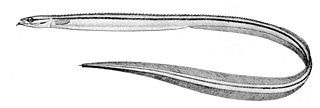
The quillfish,, is a species of marine ray-finned fish, it is the only species in the genus Ptilichthys and family Ptilichthyidae. This fish occurs in the northern North Pacific Ocean.

The Hemitripterinae is a subfamily of the scorpaeniform family Agonidae, known as sea ravens or sailfin sculpins. They are bottom-dwelling fish that feed on small invertebrates, found in the northwest Atlantic and north Pacific Oceans. They are covered in small spines.

The cabezon is a large species of sculpin native to the Pacific coast of North America. Although the genus name translates literally as "scorpion fish", true scorpionfish belong to the related family Scorpaenidae. The cabezon is the only known member of its genus.

The Trichodontidae, or sandfishes, are a small family of ray-finned fishes from the order Scorpaeniformes. The species in this family are found in the North Pacific Ocean.
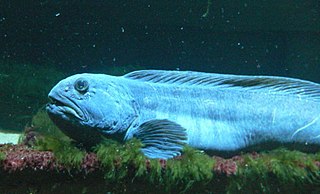
Zoarcoidei is a suborder of marine ray-finned fishes belonging to the order Perciformes. The suborder includes the wolffishes, gunnels and eelpouts. The suborder includes about 400 species. These fishes predominantly found in the boreal seas of the northern hemisphere but they have colonised the southern hemisphere.
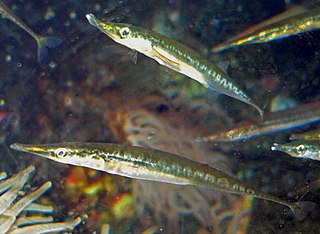
Aulorhynchidae, the tube-snouts, is a small family of marine ray-finned fishes belonging to the suborder Gasterosteoidei in the order Perciformes. These fishes are found in the northern Pacific Ocean.

The Zaniolepididae is a family of marine ray-finned fishes classified within the suborder Cottoidei of the order Perciformes. They are found in the North Pacific Ocean.

Cryptacanthodes is a genus of marine ray-finned fishes belonging to the monogeneric family Cryptacanthodidae, commonly referred to as wrymouths. Three of the four species are found in the Pacific Ocean with one species native to the western Atlantic Ocean where they are benthic fishes, tunneling through soft substrates. It is currently the only known genus in its family.
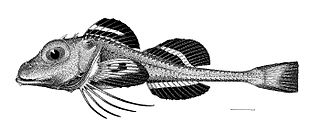
Ereunias is a monotypic genus of marine ray-finned fish belonging to the family Rhamphocottidae, the grunt sculpins. Its only species is Ereunias grallator which is a bathydemersal species found at depths of around 500 m (1,600 ft) in the northwestern Pacific Ocean off Japan. This species attains a maximum published total length of 30 cm (12 in). This species was first formally described in 1901 by the American ichthyologists David Starr Jordan and John Otterbein Snyder from Misaki, Sagami in Japan. Jordan and Snyder proposed the new genus Ereunias for the new species. The genus name is derived from ereunao, meaning "to explore" which may refer how it uses elongated pectoral-fin rays as feelers or “feet” to explore the substrate; suffixed with ias which is used in some Greek names for fishes. The specific name grallator is "stiltwalker" in Latin and is an allusion to the elongated pectoral fin rays. Along with the genus Marukawichthys this taxon was classified in the family Ereunidae but this was synonymised with the Rhamphocottidae in 2014.
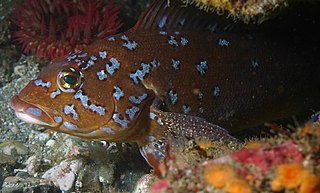
Hexagrammos is a genus of marine ray-finned fishes belonging to the family Hexagrammidae, the greenlings. These fishes are found in the north Pacific Ocean.

Cottoidei is a suborder of ray-finned fishes which, according to the 5th edition of Fishes of the World, is placed within the order Scorpaeniformes, alongside the scorpionfishes, flatheads, eelpouts, sticklebacks and related fishes.
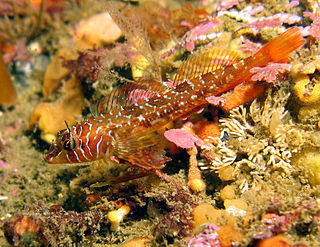
Jordaniidae is a small family of marine ray-finned fishes belonging to the order Perciformes. These fishes are found in the eastern North Pacific Ocean.
Rhamphocottus nagaakii is a species of marine ray-finned fish belonging to the family Rhamphocottidae, the grunt sculpins. This species was first formally described in 2022 with its type locality given as off Minami-Sanriku cho in Miyagi Prefecture of Japan. It is thought to have evolved from a common ancestor to the grunt sculpin but the two species were thought to have been separated by a cooling event during either the Pliocene or Miocene. This species differs from the grunt sculpin genetically and morphologically. The specific name honours Nagaaki Satoh, a professional diving instructor, who was the first to observe the reproductive behaviour of R. nagaakii and passed these observations to the species' describers.



















